What Engagement That Converts Really Means in 2026
In 2026, Instagram’s algorithm rewards depth of interaction, not surface-level reactions. Brands and creators who understand this shift know that a thousand likes mean little if none of those users click, save, or reply. True engagement is about actions that show interest, trust, and intent to buy — not just attention.
From Vanity Metrics to Value Metrics
Vanity metrics such as likes or follower counts once dominated social media strategy. Today, Instagram’s ranking system favors meaningful engagement that signals genuine audience behavior. These actions influence both visibility and sales potential.
| Engagement Type | What It Indicates | Sales Conversion Potential |
|---|---|---|
| Saves | Future intent — the user plans to revisit your content or product. | Very High |
| Shares | Peer endorsement — builds credibility and extends reach organically. | High |
| Comments | Active dialogue — proof of community and emotional connection. | Medium to High |
| Profile Visits | Curiosity about your brand or offer — indicates purchase exploration. | Medium |
| Link Clicks / Product Tag Taps | Strong buying intent — direct funnel entry to conversion. | Very High |
Why This Shift Matters
Instagram’s ecosystem has evolved from passive scrolling to interactive shopping. Engagement signals now directly affect both algorithmic ranking and shopping visibility. For instance, posts with higher save and share ratios are prioritized in Explore and Shop tabs, increasing organic reach and conversion probability.
Brands are also integrating these engagement signals into ad retargeting. When users save or comment on a product post, they can automatically enter a remarketing audience — allowing creators to convert engagement into retargeted sales with precision.
The Engagement-Value Equation
Think of engagement in 2026 as a value equation:
Engagement Value = (Saves × 3) + (Shares × 2) + (Comments × 1.5) + (Profile Visits × 1)
This mindset helps creators focus on the right activities — encouraging meaningful saves and shares through educational, emotional, or highly relatable content rather than chasing vanity likes.
Real-World Insight
Data from Meta’s Creator Benchmark 2026 shows that posts with above-average save rates drive up to 4.2 times more product link clicks than those relying primarily on likes. In other words, content that educates or inspires purchase consideration converts best.
Next, we’ll break down how this engagement translates into an actionable Instagram Sales Funnel — from awareness to checkout — using 2026’s newest tools and analytics.
The Instagram Sales Funnel (2026 Model)
In 2026, Instagram functions as a complete sales ecosystem rather than a top-of-funnel awareness tool. Its algorithm, analytics, and integrated shopping features allow brands and creators to move audiences from discovery to purchase without leaving the app. Understanding the Instagram Sales Funnel is essential for turning engagement into measurable revenue.
Why the Funnel Matters More Than Ever
Most creators still treat Instagram as a content platform, not a conversion system. However, in today’s landscape, every post, story, and Reel can play a defined role in your funnel. When these layers are aligned — awareness, interest, decision, and action — engagement naturally transforms into sales.
The Four Stages of the 2026 Instagram Funnel
Instagram’s funnel mirrors classic marketing psychology but uses platform-specific features at each step. Below is the 2026 breakdown:
| Funnel Stage | Goal | Instagram Features | Example Action |
|---|---|---|---|
| Awareness | Reach new audiences and attract first-time viewers. | Reels, Explore tab, Hashtags, GEO-targeted posts. | Create educational or entertaining Reels optimized for saves and shares. |
| Interest | Encourage curiosity and build trust. | Stories, Carousel posts, Highlights. | Share behind-the-scenes stories, polls, or Q&A to spark dialogue. |
| Decision | Show value and trigger buying intent. | Product Tags, Guides, Link-in-Bio, Story Stickers. | Publish Reels with tagged products or “Shop the Look” Stories. |
| Action | Convert engagement into sales. | Checkout, DMs, Collab posts, Broadcast Channels. | Respond to DMs with personalized links and highlight testimonials. |
Integrating Funnel Stages into Content Planning
Effective sales funnels on Instagram rely on consistency and intention. Each content format should serve a clear stage in the customer journey:
- Reels: Capture awareness through storytelling and virality.
- Stories: Maintain interest and demonstrate authenticity.
- Feed Posts: Educate and persuade, using visuals with value propositions.
- DMs and Lives: Close sales through personal engagement and limited-time offers.
By linking these stages with clear calls to action — “Save this,” “DM for details,” or “Tap to shop” — every engagement becomes a step toward purchase. Unlike traditional funnels, Instagram’s looped structure means a single follower can circulate between engagement and action repeatedly through different content types.
Example
The Creator Funnel in Practice
Consider a beauty creator launching a skincare line. They post an educational Reel about skin hydration (Awareness), follow with Stories showing product texture and reviews (Interest), tag the product in a carousel (Decision), and reply to comments or DMs with a discount code (Action). Each layer complements the next, creating a fluid, self-sustaining sales cycle.
From Linear to Circular Funnels
In 2026, Instagram’s funnel is no longer linear. Audience members may enter at any point — a shared Reel, a tagged Story, or a friend’s recommendation — and still convert. The goal is to maintain continuity of message so every piece of engagement leads closer to trust and transaction.
Next, we’ll explore how to use Instagram’s Built-In Sales Tools — product tags, checkout, and interactive stickers — to make that conversion happen seamlessly.
Using Instagram’s Built-In Sales Tools
Instagram has evolved into a full-scale commerce platform, blurring the line between content and conversion. The key to turning engagement into sales lies in using the platform’s native tools strategically. In 2026, creators who integrate product tags, stickers, checkout, and Guides into their daily content outperform those relying solely on external links.
Product Tags
Turning Curiosity into Clicks
Product tagging allows creators and brands to link specific items directly within Reels, posts, and Stories. When used effectively, it shortens the path from discovery to purchase by removing the need for followers to leave the app. A study by Meta Business Insights (2026) shows that posts with product tags experience a 28% higher conversion rate compared to untagged posts.
- Tag products in Reels where they’re actively demonstrated.
- Include clear captions explaining why the product is featured.
- Use analytics to track tap-through and add-to-cart actions from tagged content.
For small creators, tagged Reels function like shoppable video ads — except they build organic trust instead of costing ad spend.
Story Stickers
Micro-Conversions that Build Momentum
Stories remain the most direct touchpoint for impulse actions. Interactive elements such as Polls, Question Boxes, and Link Stickers turn passive viewers into active participants. Each tap not only feeds the algorithm but also qualifies users based on their interest level.
To optimize for sales:
- Use “This or That” polls to introduce products subtly.
- Link Sticker to direct traffic to product pages or affiliate offers.
- Highlight Story responses in your next post to continue the conversion thread.
These micro-actions — tapping, voting, replying — strengthen buyer intent and increase the likelihood of future purchases.
Instagram Checkout
Seamless Shopping Without Distraction
Checkout integration allows users to purchase directly on Instagram without opening a browser. This feature reduces cart abandonment caused by slow page loads or app switching. It’s particularly effective for impulse purchases driven by creator recommendations.
Brands can connect their product catalog through Meta Commerce Manager to activate in-app checkout. Creators partnering under affiliate programs or branded content can then tag those items in eligible regions.
Key benefits include:
- Faster conversions due to one-click in-app purchases.
- Improved user trust from verified payment security.
- Higher ROI for creators in commission-based collaborations.
Instagram Guides
The Hidden Conversion Asset
Instagram Guides act as curated mini-blogs within your profile. They allow creators to bundle posts, Reels, or products around specific themes — such as “Top Skincare Picks” or “Best Content Tools for 2026.” These Guides often rank in Google search results and remain evergreen, providing passive discovery opportunities long after initial posting.
- Combine informational posts with tagged product Reels in one Guide.
- Add short buyer tips in captions to drive intent.
- Share the Guide link in Stories or DMs as a soft-sell asset.
Guides work best as part of a larger sales funnel: create awareness via Reels, build interest with Stories, then share a relevant Guide during DM conversations.
Commerce API and Cross-Platform Tracking
In 2026, Instagram’s Commerce API connects with analytics platforms like Shopify, WooCommerce, and Google Analytics 4. This integration allows creators and brands to track purchase attribution, content ROI, and engagement quality across both Instagram and their storefronts.
When configured properly, this system provides full-funnel transparency — showing exactly which Reel or Story led to each sale. For e-commerce and affiliate creators, this is the ultimate bridge between engagement metrics and real-world income.
By combining these tools into a single workflow — tagged posts, interactive Stories, in-app checkout, and Guide-based education — creators can build an automated conversion system that turns followers into loyal buyers without leaving Instagram.
Next, we’ll look at how to measure which engagement signals actually trigger sales by focusing on Saves, Shares, and Comments — the conversion metrics that drive long-term profitability.
Leveraging DMs and Community Relationships
In 2026, Direct Messages (DMs) have become one of the most effective conversion channels on Instagram. What began as a casual communication feature has evolved into a high-intent sales environment where trust, personalization, and responsiveness determine outcomes. The creators and brands that master DM-based selling often outperform those relying entirely on ads or links in bio.
DMs: The New Sales Frontline
Instagram’s 2026 algorithm now prioritizes relationship signals — private messages, replies, and interactions inside chat threads. These micro-conversations help the algorithm understand connection depth and brand trust, which in turn increases feed visibility and conversion opportunities. DMs are not cold messages; they’re warm follow-ups to engagement actions such as Story replies, comments, or product tag taps.
- Trigger conversations naturally: reply to Story interactions with context rather than sales pitches.
- Personalize your message: reference a specific post or question the user engaged with.
- End with a soft CTA: “Would you like the link?” or “Want to see the bundle option?”
Every DM thread is a private sales funnel where relevance and timing convert faster than public calls to action.
The Psychology of Trust in Private Conversations
Public engagement builds awareness, but private conversations close the sale. DMs allow for vulnerability, curiosity, and authenticity — all essential for purchase decisions. According to Social Insider’s 2026 Creator Behavior Report, 63% of small-business sales influenced by Instagram start in a private message or reply chain.
To maintain credibility:
- Respond promptly (within 2 hours) to maintain momentum and trust.
- Use conversational tone — avoid robotic or templated responses.
- Offer quick answers or visuals instead of sending users back to your link-in-bio.
Instagram’s “Quick Replies” feature can still be customized — keep them natural by inserting personal touches like first names or product references.
Broadcast Channels and Close Friends Lists
In 2026, two new features extend the power of private community marketing: Broadcast Channels and Close Friends Stories.
- Broadcast Channels: function as one-to-many private groups for exclusive updates, product drops, or insider tips. Followers receive notifications, making engagement rates 3x higher than standard Stories.
- Close Friends: lets you segment your most active audience for early access or beta offers. This small circle feels personal and premium, increasing perceived exclusivity and purchase motivation.
Both features enable you to nurture long-term relationships while maintaining the personal tone that drives conversions.
DM Workflow for Creators and Brands
Here’s a proven workflow for using DMs to move followers from engagement to checkout:
- Attract: Post Reels or Stories prompting users to comment or react.
- Engage: Reply to their comment or reaction with a follow-up message.
- Qualify: Ask a question that identifies their intent or needs.
- Offer: Send a product tag, checkout link, or discount code inside the conversation.
- Close: Thank them personally and invite feedback after purchase.
This conversational selling method mimics one-to-one retail experiences — efficient, trust-driven, and scalable with the right tone and tools.
Automating Responsiveness Without Losing Authenticity
Instagram’s 2026 update now integrates AI-assisted chat responses for business and creator accounts. While automation helps manage volume, the best results come from hybrid models — initial automation for greeting and information, followed by personalized replies.
Effective automation setup includes:
- Trigger responses after specific keywords (e.g., “price”, “details”, “discount”).
- Use AI only to guide users toward human conversation, not replace it.
- Maintain tone consistency between automated and manual replies.
DMs and private spaces are no longer side channels — they’re the foundation of trust-based commerce on Instagram. Creators who manage these interactions with care turn engagement into repeat customers and community loyalty.
In the next section, we’ll explore how Story Highlights and Reels serve as long-term conversion assets that keep your content — and sales potential — evergreen.
Story Highlights & Reels as Sales Assets
Stories and Reels have become the most influential tools in Instagram’s 2026 content ecosystem. They don’t just build awareness — they guide followers directly through your sales funnel. When structured intentionally, these formats function as evergreen sales assets that work long after initial posting.
Story Highlights
Your Permanent Storefront
Instagram Stories are temporary, but Highlights turn them into long-term conversion resources. By curating your best Stories into organized collections, you transform your profile into a visual sales catalog that’s always accessible to new visitors.
Top-performing creators treat Highlights as mini-landing pages. Each section is designed to educate, persuade, or close — not just entertain. A well-structured Highlight series can convert a new visitor into a paying customer within minutes.
- Highlight 1: “Best Sellers” — Showcase your most popular or profitable products.
- Highlight 2: “How It Works” — Explain features or benefits using simple story visuals.
- Highlight 3: “Testimonials” — Repost customer feedback, reviews, or reaction Stories.
- Highlight 4: “Offers & Codes” — Update discount information or limited-time promotions.
Keep visuals clean, with consistent brand colors and easy-to-read text overlays. Revisit and update Highlights monthly to ensure links, stickers, and product tags remain active and relevant.
Reels
Your Always-On Sales Engine
Instagram Reels continue to dominate both discovery and conversion. In 2026, Reels with a clear product focus — educational, demonstrative, or testimonial-style — consistently outperform static posts by 4x in purchase rate.
To maximize their impact, structure Reels with the 3-Stage Engagement Model:
- Hook: Capture attention in the first three seconds with movement or problem statements.
- Value: Demonstrate how the product or service solves a real user challenge.
- Action: End with a direct but non-intrusive call-to-action (e.g., “Check my bio” or “Tap the tag”).
Reels optimized for sales often combine storytelling and education — not pure promotion. Creators who show real-world application (unboxing, tutorials, comparisons) establish stronger emotional connection and buyer trust.
Integrating Highlights and Reels into the Funnel
Both Reels and Highlights support every stage of the sales funnel:
| Funnel Stage | Content Type | Purpose |
|---|---|---|
| Awareness | Reels | Reach new audiences with educational or inspirational content. |
| Interest | Stories / Highlights | Provide behind-the-scenes context, user reactions, or answers to FAQs. |
| Decision | Reels + Product Tags | Demonstrate value through results, transformations, or social proof. |
| Action | Highlights (Offers & Links) | Deliver promo codes or checkout links directly in Stories or pinned Highlights. |
The Power of Pinned Reels
Pinned Reels extend the funnel effect even further. By keeping your top-performing or high-conversion Reels visible at the top of your profile grid, you continuously capture new visitors and guide them into your offer path.
Best practices for pinned Reels include:
- Select 2–3 Reels that clearly communicate your core value proposition.
- Pin at least one educational and one conversion-driven video.
- Update pinned Reels quarterly based on insights and campaign performance.
When paired with optimized Highlights, these Reels transform your Instagram profile into a dynamic, automated sales environment — where content engagement naturally leads to checkout.
Next, we’ll explore how to measure what truly converts by tracking Instagram’s evolving analytics — focusing on the engagement signals and performance metrics that reflect real buyer intent.
Track What Converts — Not What Looks Good
Most creators fall into the same trap — chasing vanity metrics. While likes and views might look impressive, they rarely correlate with revenue. In 2026, successful Instagram creators and businesses track conversion-based engagement instead: saves, product tag taps, link clicks, DM replies, and profile actions that move followers toward purchase.
Why Data-Driven Decisions Matter
Instagram’s analytics system has matured dramatically since 2023. Today’s dashboards within Professional Accounts and Meta Commerce Manager provide precise insights into audience intent. Creators can now see which posts lead to actual product interactions, allowing smarter decisions on where to focus energy and budget.
Tracking the right data ensures your strategy scales sustainably. A viral Reel that gets 100K views but zero clicks is a distraction — a Story with 800 views and 100 link taps is a success. The goal is not popularity; it’s profit-driven engagement.
The Core Conversion Metrics for 2026
Focus on the metrics that show movement toward a transaction. These are the five engagement indicators that matter most in 2026:
| Metric | Why It Matters | Recommended Benchmark |
|---|---|---|
| Product Tag Taps | Shows direct purchase intent from Reels or feed posts. | 1–3% of total viewers |
| Story Link Clicks | Measures active decision interest during story interactions. | 3–5% of total viewers |
| DM Replies | Represents trust — high conversion potential. | 1 reply per 200–300 story views |
| Profile Visits → Link Clicks | Tracks how effectively your bio converts curiosity to action. | 20–30% click-through ratio |
| Saves & Shares | Indicate future purchase or peer endorsement behavior. | Above 4% of total engagement |
Tools for Measuring What Matters
Beyond Instagram Insights, third-party analytics platforms now provide more granular tracking and cross-platform integration. Each tool specializes in different aspects of performance evaluation.
- Later Analytics: Visual content mapping that links engagement spikes to specific posts or campaigns.
- Sprout Social: Deep community and DM interaction metrics — ideal for trust and retention measurement.
- Metricool: Tracks engagement-to-click ratios and calculates post ROI automatically.
- GA4 (Google Analytics 4): Integrates referral tracking from Instagram to your e-commerce or service page.
When these platforms are connected through Meta’s Commerce API, they provide a full funnel view — from impression to checkout — allowing creators to identify exactly which content drives income.
Evaluating True ROI from Instagram Content
ROI on Instagram in 2026 is no longer abstract. Every link click, tag tap, or DM can be attributed to a monetary outcome. To measure accurately, assign estimated revenue to each key event:
ROI per Post = (Total Sales Value ÷ Content Cost) × 100For example, if a creator invests $50 producing a Reel that drives 10 purchases worth $25 each, the ROI is 500%. This clarity helps prioritize content types and funnels that bring measurable returns — not just engagement spikes.
Using Data to Improve Future Performance
Tracking is only valuable if it leads to action. By reviewing your analytics weekly, you can identify repeatable behaviors:
- Which content type generates the most product interactions?
- What time of day drives more Story taps or DM replies?
- Which caption tone gets higher saves or shares?
Creators who combine creative testing with consistent tracking achieve exponential growth. They no longer post reactively — they post strategically, guided by verified audience data.
Common Mistakes That Kill Conversions
Even with high engagement, many creators struggle to see results because they unknowingly sabotage their own sales funnel. In 2026, where Instagram’s algorithm heavily favors authentic and strategic content, these missteps can limit visibility, erode trust, and waste valuable opportunities for revenue growth.
1. Treating Engagement as the Final Goal
One of the most common errors is assuming that high engagement equals success. While likes and comments matter, they are only the starting point of a buyer’s journey. Creators who fail to add conversion layers — product tags, links, CTAs, or DM follow-ups — often end up with large audiences but little income.
Always ask: “What happens after the engagement?” Each interaction should lead to a deeper action: saving, clicking, or purchasing. Without direction, engagement stalls and your audience never moves into the sales stage.
2. Posting Without Funnel Strategy
Random posting may increase visibility temporarily but doesn’t drive predictable outcomes. Every post should serve a purpose in your funnel — either attracting, educating, or converting. When creators publish disconnected content, their followers become passive consumers instead of active buyers.
- Plan Reels for awareness (hooks and education).
- Use Stories to nurture and answer objections.
- End with Highlights or DMs to close the sale.
Funnel-based content sequencing maintains momentum and conditions followers to act naturally without feeling “sold to.”
3. Ignoring Product Tagging and Checkout Tools
Some creators still rely solely on captions or link-in-bio redirects — a costly mistake. Instagram’s 2026 in-app commerce tools are designed to remove friction.
Posts without product tags or Story links create unnecessary steps, reducing the likelihood of conversion.
According to Meta’s Commerce Data Insights (2026), shoppable posts convert 41% faster than external link redirections. Every Reel, post, or Story featuring a product should have an embedded path to purchase.
4. Failing to Build Relationship Capital
Modern followers are highly perceptive. They can recognize when creators engage purely for algorithmic gain versus genuine interest. Failing to nurture your community weakens emotional trust — and trust is the deciding factor for sales.
Prioritize meaningful replies, comment interaction, and Story responses. The goal is not to sell every time but to build relationship capital that pays off later. The more your audience feels connected, the easier it becomes to convert them authentically.
5. Over-Promotion Without Value
Excessive sales pitches can trigger audience fatigue and unfollows. In 2026, successful monetization depends on value-driven marketing — balancing 70% education or entertainment with 30% promotion. Audiences reward creators who offer consistent insight, not constant offers.
To maintain this balance:
- Share user-generated content or testimonials instead of repeating product ads.
- Provide mini-guides, tips, or Reels demonstrating solutions.
- Rotate promotional content with relatable stories or behind-the-scenes views.
When value precedes selling, conversion feels natural — not forced.
6. Neglecting Data and Feedback
Another overlooked mistake is ignoring analytics or follower feedback. Creators who post blindly without reviewing insights miss out on data that reveals what actually drives clicks and purchases. Similarly, failing to collect testimonials or polls prevents understanding of real audience needs.
Use data loops to refine your process:
- Compare Story link clicks versus DM conversions weekly.
- Run polls asking which topics or products followers want more of.
- Replicate high-performing content styles with updated CTAs.
Creators who test, measure, and adapt outperform those who rely on instinct alone.
7. Inconsistent Branding and Messaging
Mixed visuals or inconsistent tone weakens your professional credibility. When new users can’t immediately understand what you sell or represent, they scroll away.
Consistency in brand colors, fonts, and messaging builds recognition and trust — both essential for long-term conversion growth.
Audit your Instagram grid and Stories monthly to ensure every element reinforces your niche and offer. A strong brand presence reduces hesitation and increases buyer confidence.
By avoiding these conversion-killing mistakes, you’ll create a frictionless buyer journey where every view and comment has a purpose.
From Engagement to Revenue
Building a Long-Term System
Turning engagement into sales isn’t a one-time trick — it’s a repeatable system. The creators and brands thriving in 2026 have shifted from short-term tactics to long-term ecosystems. Every post, Story, Reel, and DM interaction plays a strategic role in converting attention into trust and trust into income.
The Four Pillars of a Sustainable Instagram Sales System
To build a reliable monetization engine, focus on four essential pillars that reinforce each other:
- Consistency: Regular posting builds habit and recall. Creators who maintain 3–4 consistent content types (Reels, Stories, carousels, and Highlights) sustain engagement across all funnel stages.
- Community: Treat followers as collaborators. Encourage conversations, shoutouts, and UGC to make them part of your brand’s story.
- Conversion: Always provide a frictionless path to purchase — tagged products, DM workflows, or optimized bio links.
- Continuity: Reinvest engagement into retargeting. Turn past commenters or sharers into repeat customers through loyalty incentives or follow-up offers.
These four pillars create stability — ensuring your sales don’t fluctuate based on algorithm changes or post performance spikes.
Repurposing Content for Maximum ROI
Every piece of content can — and should — serve multiple purposes. A single product Reel can become a Story testimonial, a Highlight feature, and even a blog post summary on your website. By repurposing assets, you extend lifespan, boost reach, and strengthen cross-platform SEO signals.
- Convert top-performing Reels into YouTube Shorts or Pinterest video pins.
- Turn Story polls or Q&As into carousel tips or infographic Reels.
- Embed Highlights and Reels on your website’s service or product pages for SEO authority.
Repurposing builds content equity — every post becomes an asset that compounds value over time.
Building a Conversion-Focused Content Calendar
Random posting burns creativity and weakens strategy. A structured content calendar aligns posts with your funnel and keeps your messaging balanced.
Here’s a sample weekly rhythm for a 2026 conversion-focused Instagram schedule:
| Day | Content Type | Goal |
|---|---|---|
| Monday | Educational Reel | Awareness & Authority |
| Tuesday | Story Poll / Question | Engagement & Discovery |
| Wednesday | Product Tag Reel | Conversion |
| Thursday | Behind-the-Scenes Story | Trust & Connection |
| Friday | Highlight or Testimonial Post | Social Proof |
| Saturday | Community or User-Generated Content | Retention |
| Sunday | Recap Story or Call-to-Action | Sale or Signup Push |
This weekly rhythm builds natural buying intent while avoiding over-promotion fatigue. Over time, followers recognize your cadence and respond predictably to conversion posts.
Integrating Cross-Platform Touchpoints
Instagram rarely works in isolation anymore. In 2026, the top-earning creators connect their Instagram ecosystem with platforms like Pinterest, Medium, and Reddit to build SEO authority and referral traffic.
Best practices include:
- Embedding Instagram Reels in Medium stories or blog posts for backlink value.
- Cross-sharing Highlights content as Pins with keyword-optimized titles.
- Engaging on Reddit threads to build credibility and drive cold audiences back to Instagram.
This integration creates multiple entry points to your brand — ensuring your Instagram engagement converts both directly and indirectly through other digital channels.
Measuring and Refining the System
Every conversion system evolves through feedback. Monthly reviews help identify bottlenecks: low-performing post formats, weak CTAs, or underused features.
Refine your workflow by combining data from Instagram Insights, GA4, and conversion tracking tools like Metricool.
Ask these key questions each month:
- Which content type contributed the highest revenue this month?
- Which engagement metric correlates strongest with sales?
- Where are followers dropping off in the funnel?
Creators who treat Instagram as a living business ecosystem — not just a posting platform — will dominate 2026’s creator economy. Engagement may start the journey, but data, strategy, and consistency sustain the growth.
The New Era of Instagram Sales in 2026
Instagram in 2026 is no longer just a platform for visibility — it’s a complete ecosystem for trust-based, data-driven sales. Creators who understand this evolution are not chasing likes anymore; they’re designing systems that convert engagement into consistent income.
The power lies in depth over volume. A small audience that saves, shares, and interacts meaningfully is more valuable than thousands of passive scrollers. When each engagement is intentionally guided — through Stories, DMs, Reels, or Highlights — it becomes part of a predictable conversion process.
Key Takeaways
- Engagement is the gateway — but strategy turns it into revenue. Prioritize saves, shares, and private interactions over vanity likes.
- DMs and Stories close sales — they provide context, conversation, and credibility that automated ads can’t replicate.
- Data directs your growth — use analytics to learn what converts, then double down on proven funnel stages.
- Consistency builds compounding results — when every post serves a purpose, your audience learns how to engage, trust, and buy.
Monetization in 2026 isn’t about being viral — it’s about being valuable. Each creator, regardless of follower size, can now build a sustainable income stream using the platform’s built-in tools, consistent storytelling, and genuine community engagement.
As algorithms continue to evolve, one principle remains timeless: authentic engagement drives profitable relationships. Keep refining, tracking, and personalizing — and your engagement won’t just grow your brand; it will grow your revenue.

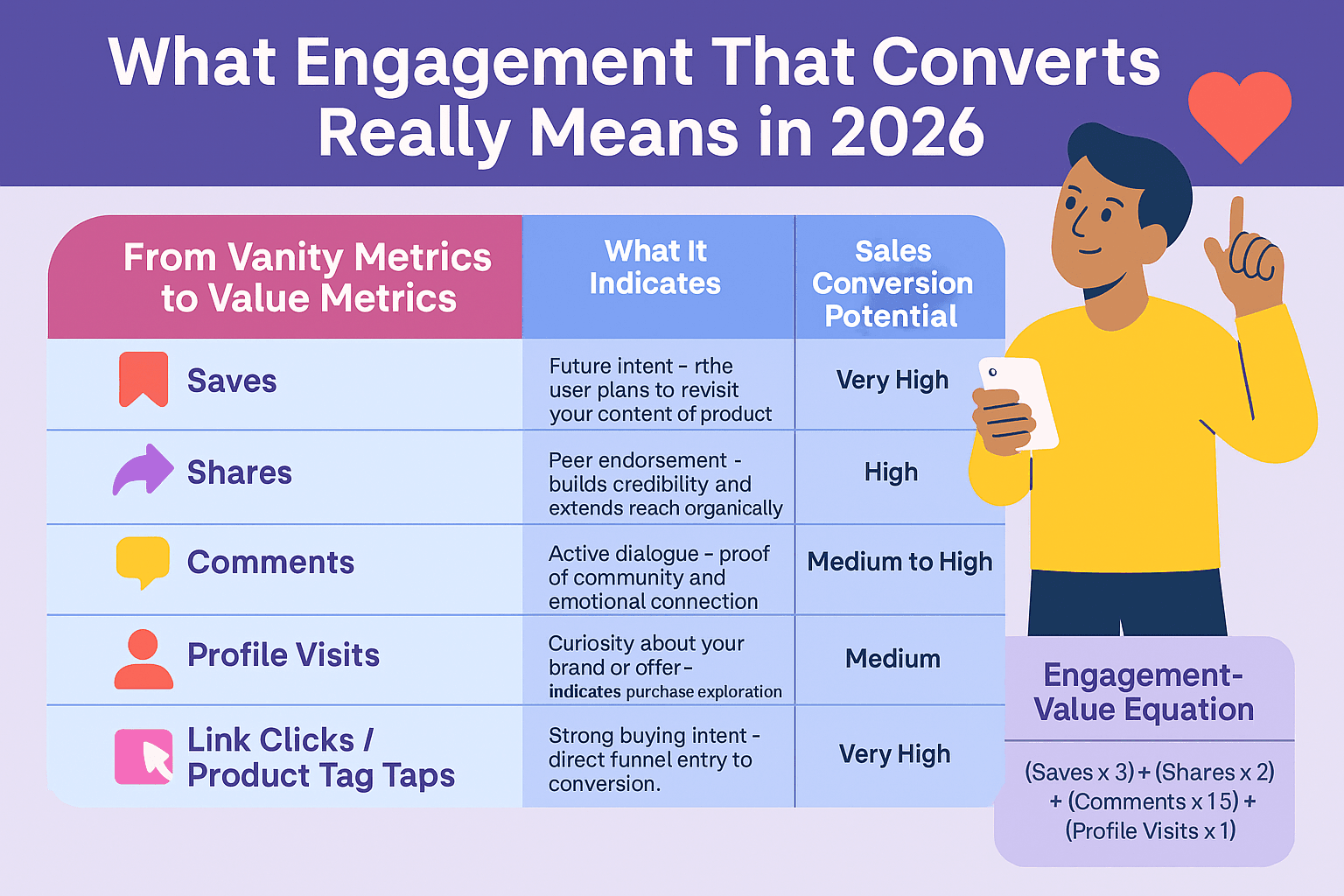
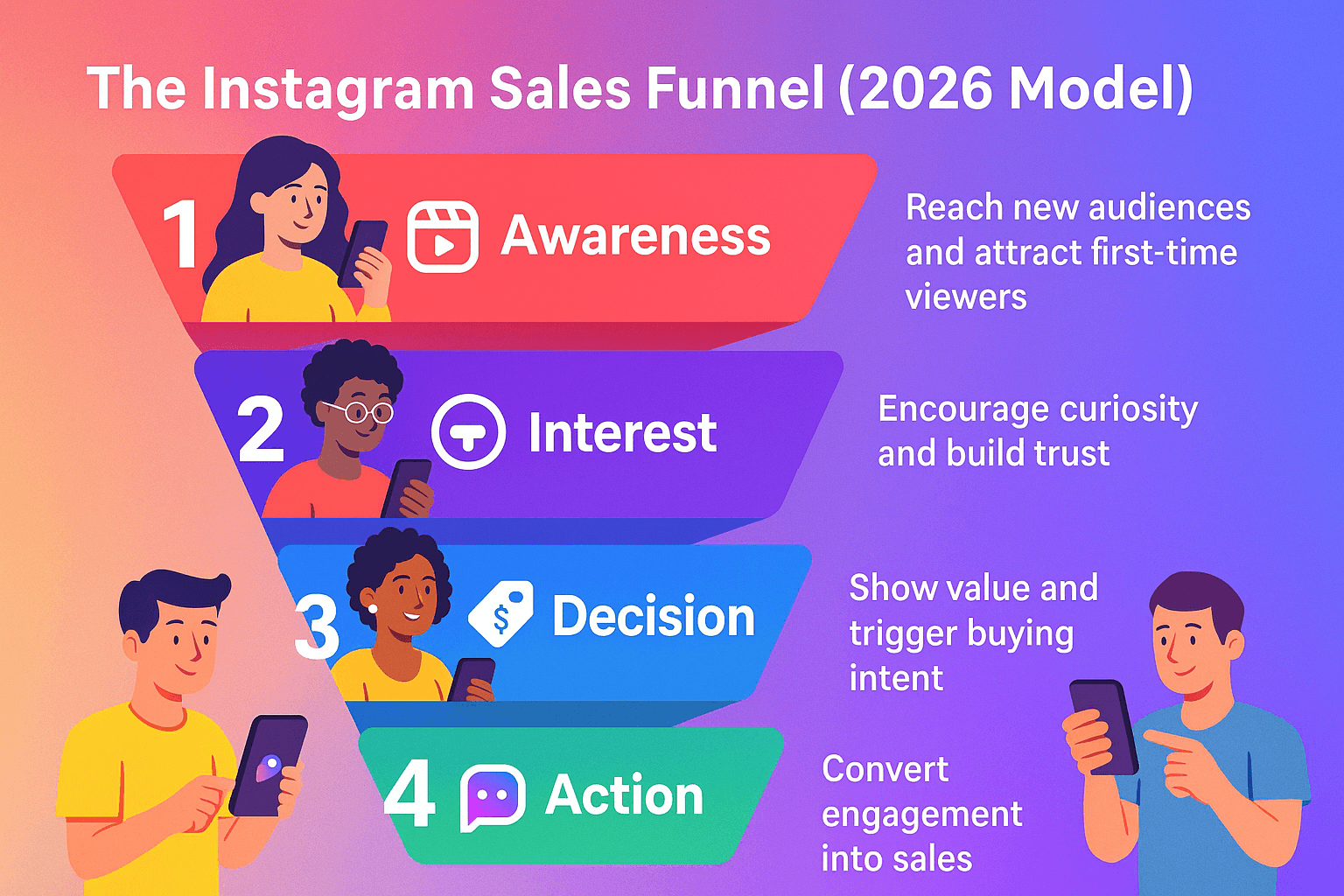
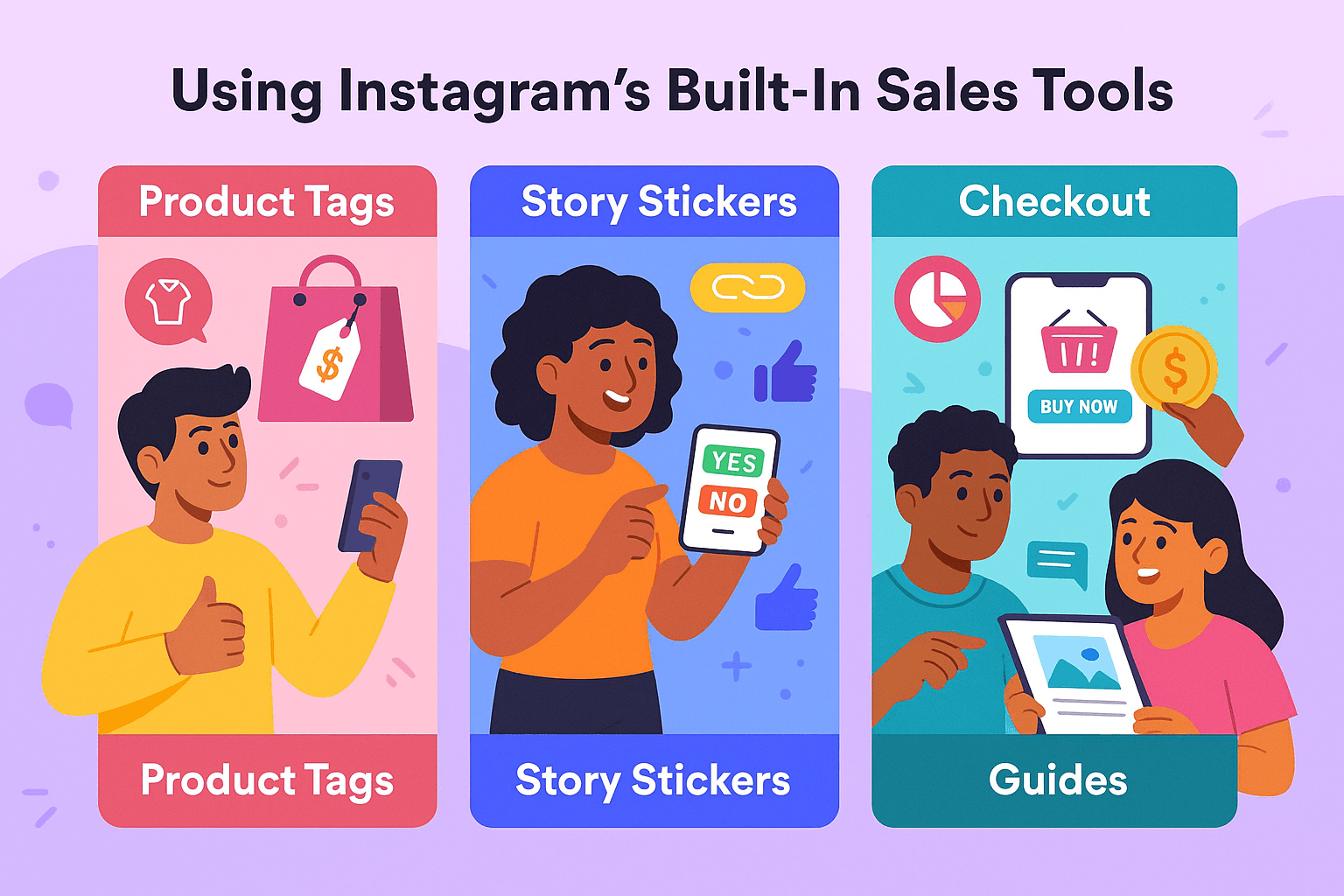
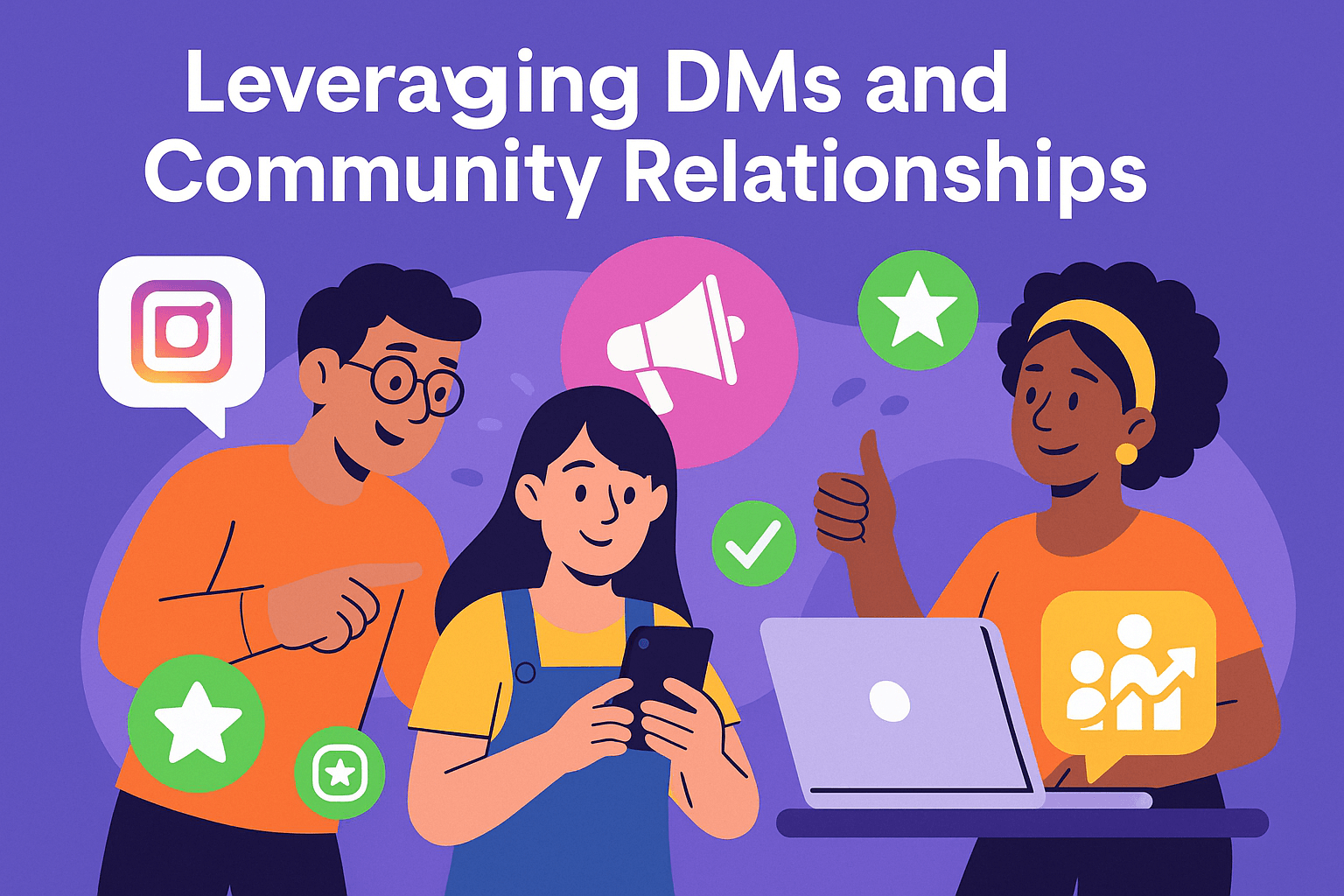
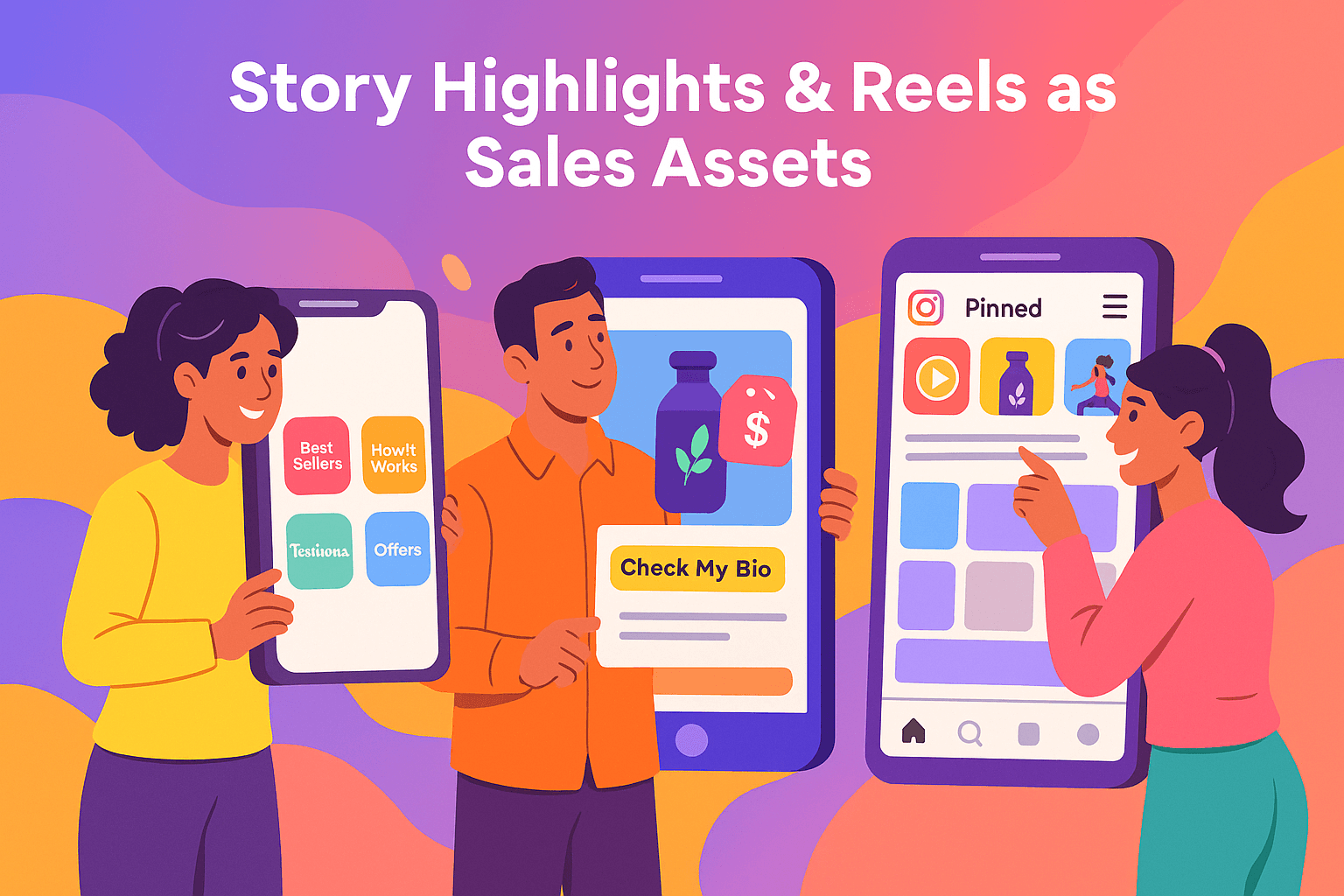
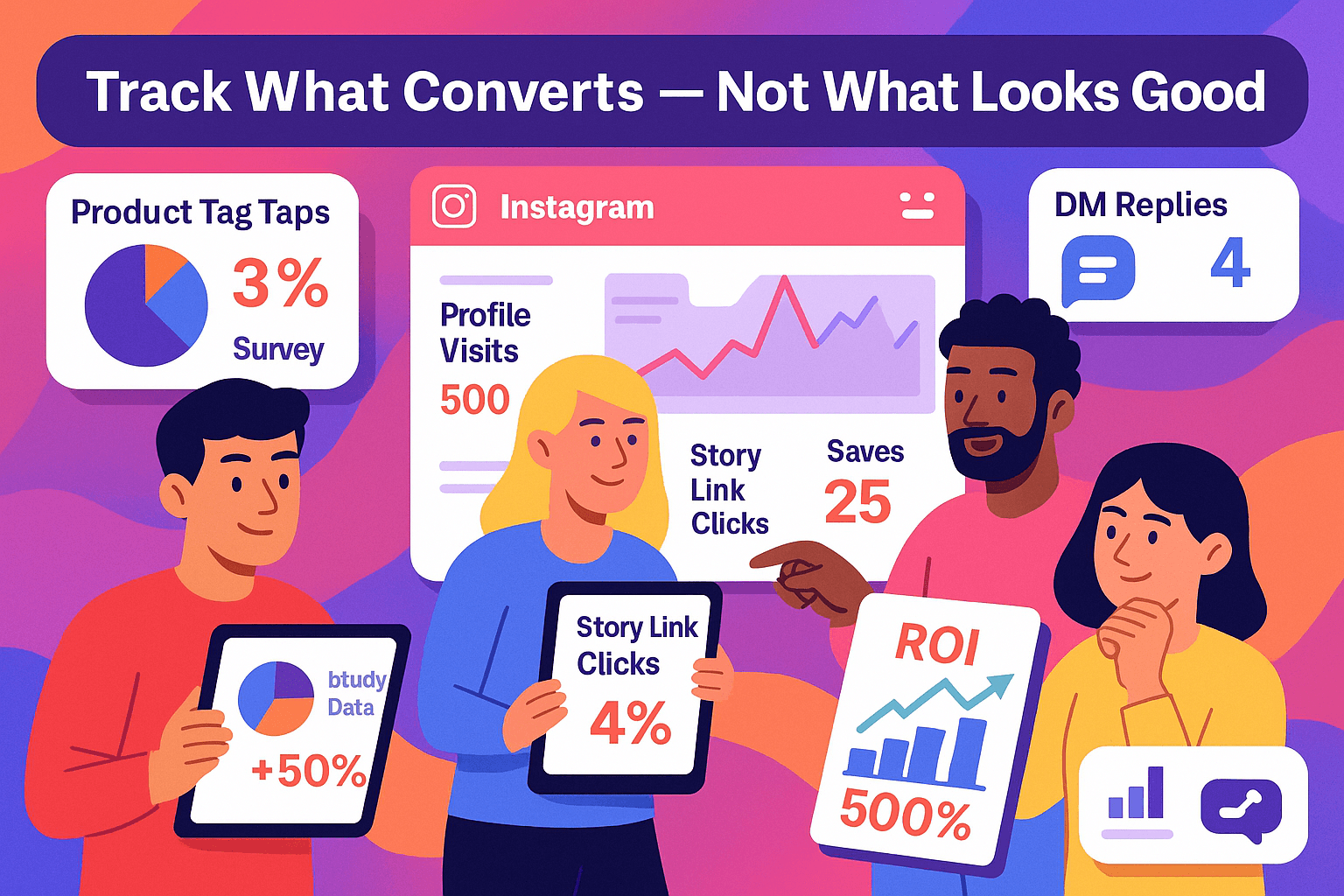
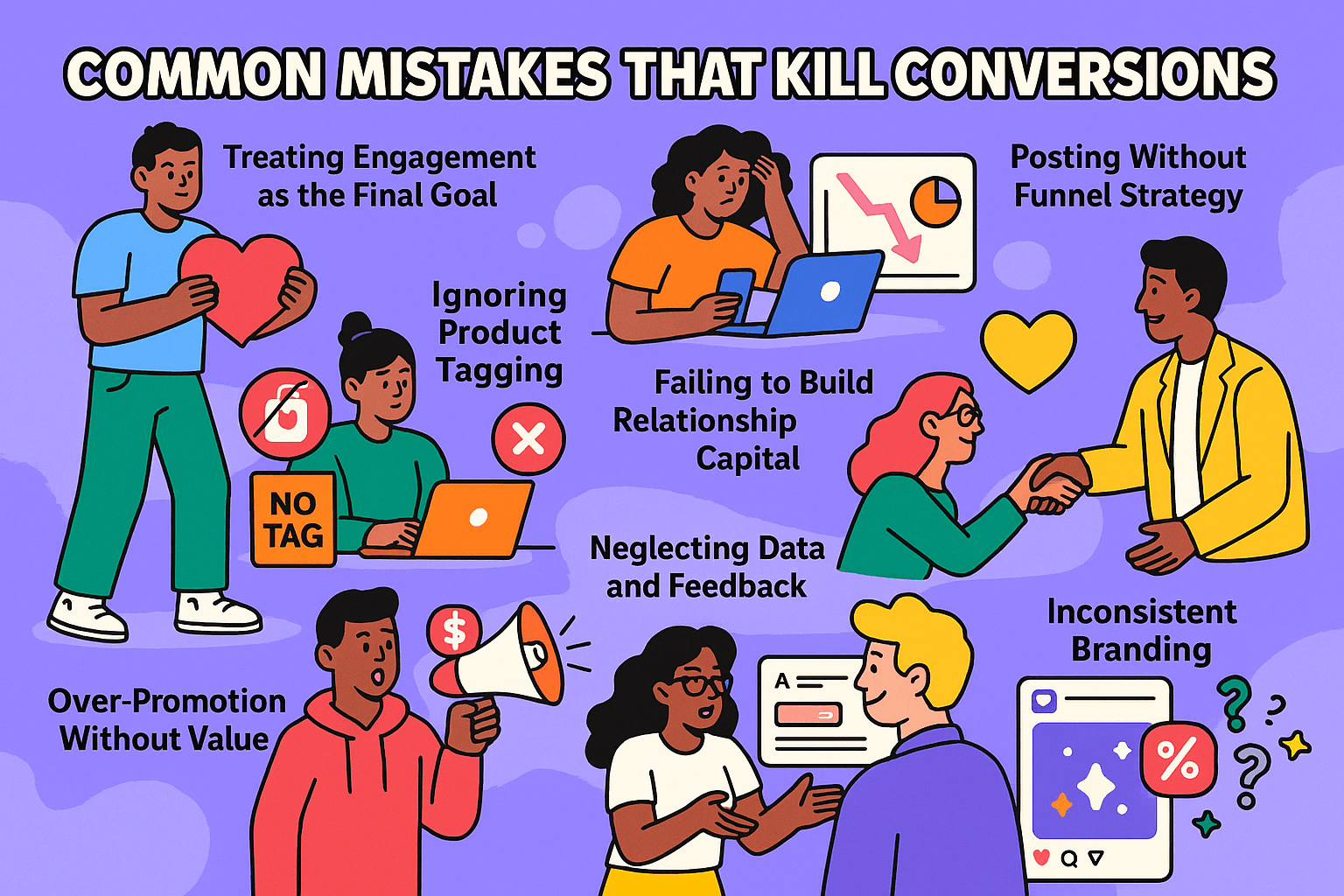
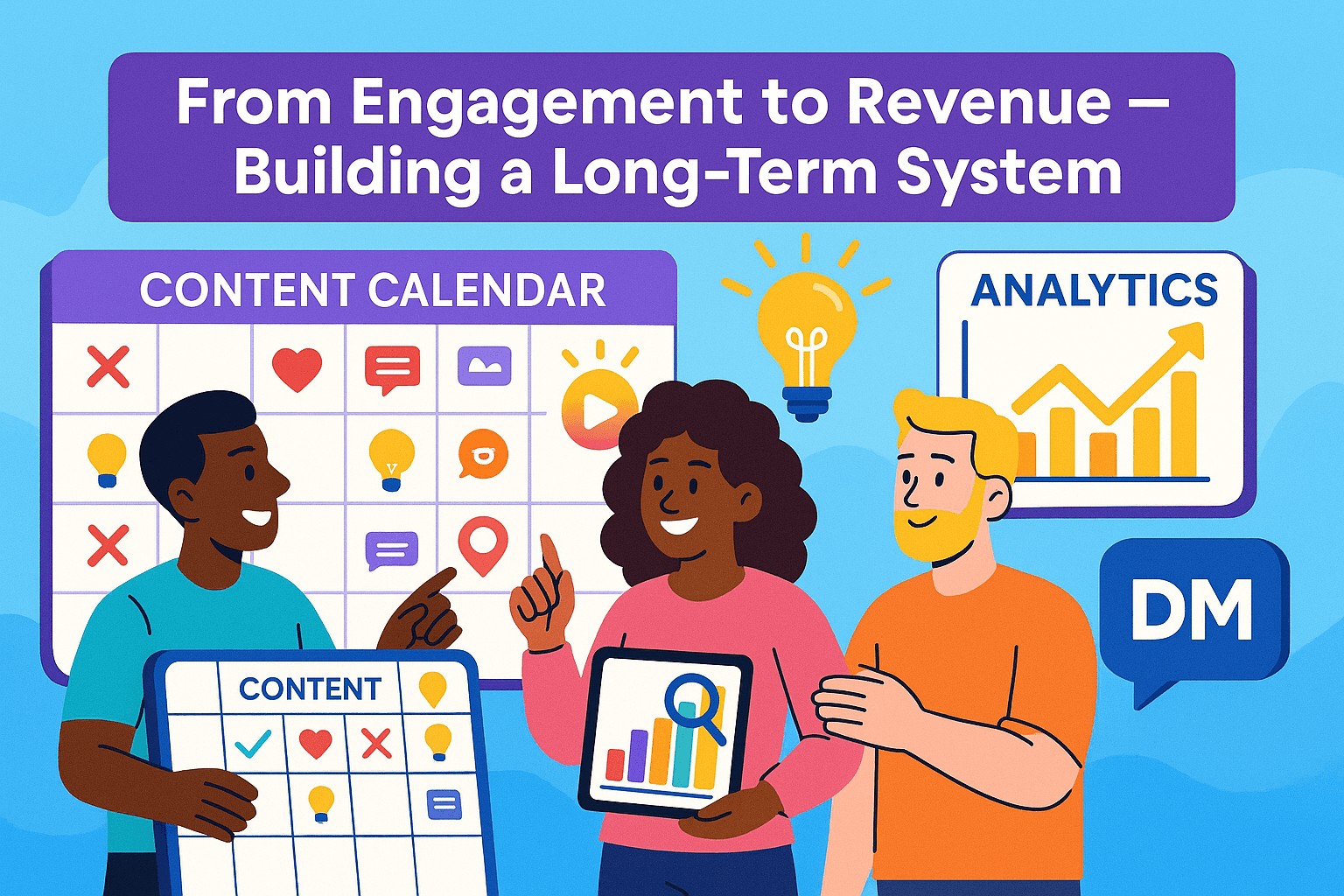





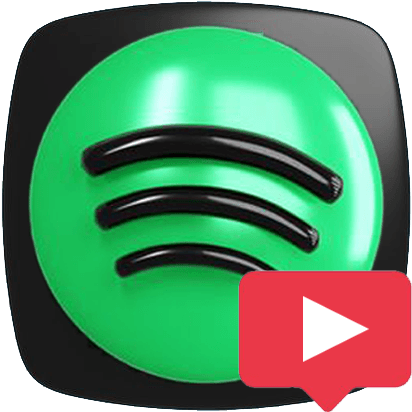
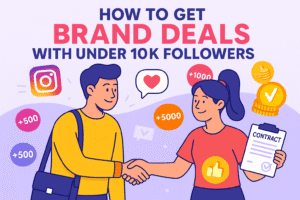
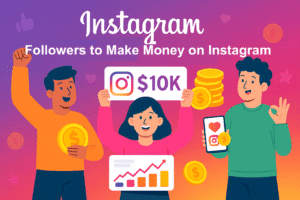
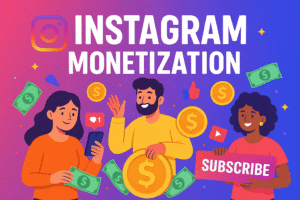
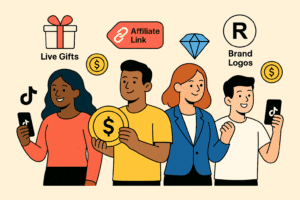
The Power of Saves, Shares, and Comments
In 2026, the true value of Instagram engagement lies in what followers do after viewing your content. Likes are now secondary signals. What drives real sales and algorithmic reach are saves, shares, and comments — the metrics that indicate intent, trust, and connection. These three actions collectively represent the “conversion engine” of Instagram.
Saves
The Silent Signal of Purchase Intent
Saves are the most underestimated engagement metric on Instagram. When a user saves a post, it shows they plan to revisit it — often during their purchase consideration phase. Meta’s 2026 creator analytics show that users who save a product post are 3.8 times more likely to click a product tag within seven days.
To increase saves:
Think of saves as your remarketing audience inside Instagram — no ads required.
Shares
The Modern Word-of-Mouth Multiplier
Shares are the bridge between engagement and reach. Each time a follower shares your post to their Story or sends it via DM, it expands your visibility to potential buyers who already trust the sharer’s opinion. This organic referral power makes shares one of the most valuable growth and sales drivers in 2026.
Encourage shares by:
High share rates also improve placement in the Explore tab and Shop suggestions, as Instagram’s algorithm now weighs shares as a high-trust signal for recommendation.
Comments
Building Connection and Social Proof
While saves and shares show intent, comments build credibility. A post with active discussions signals to both Instagram and potential buyers that your brand is relatable and trustworthy. Comments often serve as micro-testimonials — followers sharing experiences or asking detailed product questions in public view.
To maximize comment-driven sales:
Creators who maintain high comment responsiveness see a measurable rise in brand loyalty and repeat purchase rates. In fact, engagement algorithms now track creator responsiveness time as a ranking factor in Feed visibility.
Combining the Three Metrics for Maximum Conversion
When saves, shares, and comments work together, they form a feedback loop that signals authority, drives reach, and nurtures conversion intent. The 2026 engagement-to-sales equation looks like this:
In practice, a Reel that gets 400 saves and 120 shares will outperform a post with 2,000 likes but low interaction depth. These weighted metrics feed both the Explore ranking system and your future remarketing performance.
Creators and brands should regularly audit engagement breakdowns to identify which posts attract high-value interactions. Focusing on content that drives these signals ensures long-term visibility, algorithmic favorability, and revenue growth — not just temporary virality.
Next, we’ll look at how creators use DMs and community relationships to close the final sales gap — turning attention into personal connection and conversion.